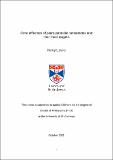Files in this item
Core effectors of plant-parasitic nematodes and their host targets
Item metadata
| dc.contributor.advisor | Jones, John T. | |
| dc.contributor.advisor | Eves-van den Akker, Sebastian | |
| dc.contributor.advisor | Mantelin, Sophie | |
| dc.contributor.author | Leslie, Kerry | |
| dc.coverage.spatial | 359 p. | en_US |
| dc.date.accessioned | 2022-12-01T15:37:58Z | |
| dc.date.available | 2022-12-01T15:37:58Z | |
| dc.date.issued | 2022-06-15 | |
| dc.identifier.uri | https://hdl.handle.net/10023/26524 | |
| dc.description.abstract | Plant parasitic nematodes infect many major food crops worldwide, causing damage valued at approximately 80 billion U.S. dollars per year (Nicol et al. 2011). As part of the parasitic process, some nematodes form a feeding site called a syncytium in the roots of their host. Specialised pathogen proteins known as effectors are thought to play critical roles in these processes. This thesis identifies and characterises a subset of core effectors conserved in the syncytia forming nematode species Globodera rostochiensis, Globodera pallida, Rotylenchulus reniformis, and Nacobbus aberrans, but that are absent from other nematodes. Three of the candidates (GROS_g02394, GROS_g02469, and GROS_g05682) have been validated as effectors using in situ hybridisation to confirm expression in the oesophageal gland cells. Further functional characterisation using in planta localisation, yeast two-hybrid (Y2H) analysis, and co immunoprecipitation for host target identification were undertaken. Using Y2H it was possible to identify an arginine N-methyltransferase (stPRMT1.1) from Solanum tuberosum as an interacting host protein for GROS_g02394. In addition, a set of novel GH53 endo-β-1, 4-galactanase effectors has been identified which may assist in invasion of the host and migration through root tissue. These genes have likely been acquired through a horizontal gene transfer event. This has given a greater insight into the invasion process and the co evolution between the nematode and its host plant. A conserved family of Cathepsin L-like peptidases has also been identified. Analysis using in situ hybridisation showed these to be intestinal proteins. Expression analysis suggests conserved functions for different family members across a range of species. | en_US |
| dc.description.sponsorship | "This work was Funded by the East of Scotland Bioscience Doctoral Training Partnership (Eastbio) (UKRI BBSRC). This work was supported by the University of St Andrews (School of Biology)." -- Funding | en |
| dc.language.iso | en | en_US |
| dc.subject | Effectors | en_US |
| dc.subject | Potato cyst nematode | en_US |
| dc.subject | Plant parasitism | en_US |
| dc.subject | Globodera rostochiensis | en_US |
| dc.subject | Globodera pallida | en_US |
| dc.subject | Syncytia | en_US |
| dc.subject | Rotylenchulus reniformis | en_US |
| dc.subject | Nacobbus aberrans | en_US |
| dc.subject | Endo-β-1, 4-galactanase | en_US |
| dc.subject | Cathepsin L-like peptidases | en_US |
| dc.title | Core effectors of plant-parasitic nematodes and their host targets | en_US |
| dc.type | Thesis | en_US |
| dc.contributor.sponsor | East of Scotland Bioscience Doctoral Training Partnership (EASTBIO) | en_US |
| dc.contributor.sponsor | University of St Andrews. School of Biology | en |
| dc.type.qualificationlevel | Doctoral | en_US |
| dc.type.qualificationname | PhD Doctor of Philosophy | en_US |
| dc.publisher.institution | The University of St Andrews | en_US |
| dc.publisher.department | The James Hutton Institute | en_US |
| dc.identifier.doi | https://doi.org/10.17630/sta/236 |
This item appears in the following Collection(s)
Items in the St Andrews Research Repository are protected by copyright, with all rights reserved, unless otherwise indicated.

